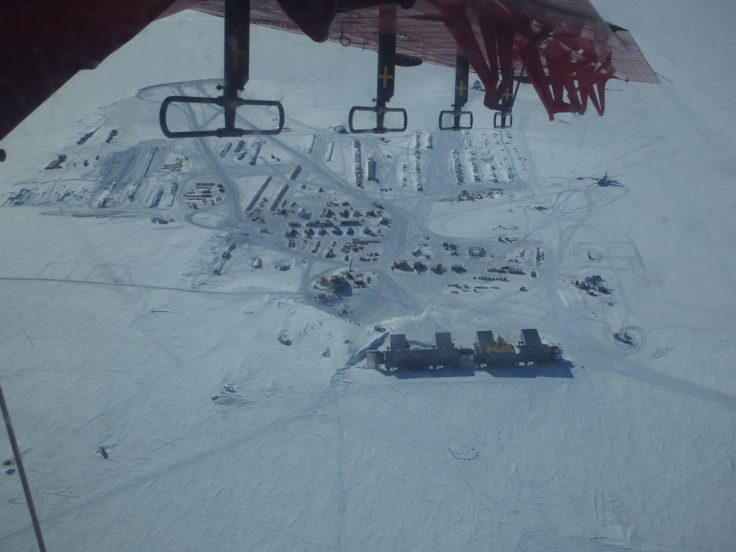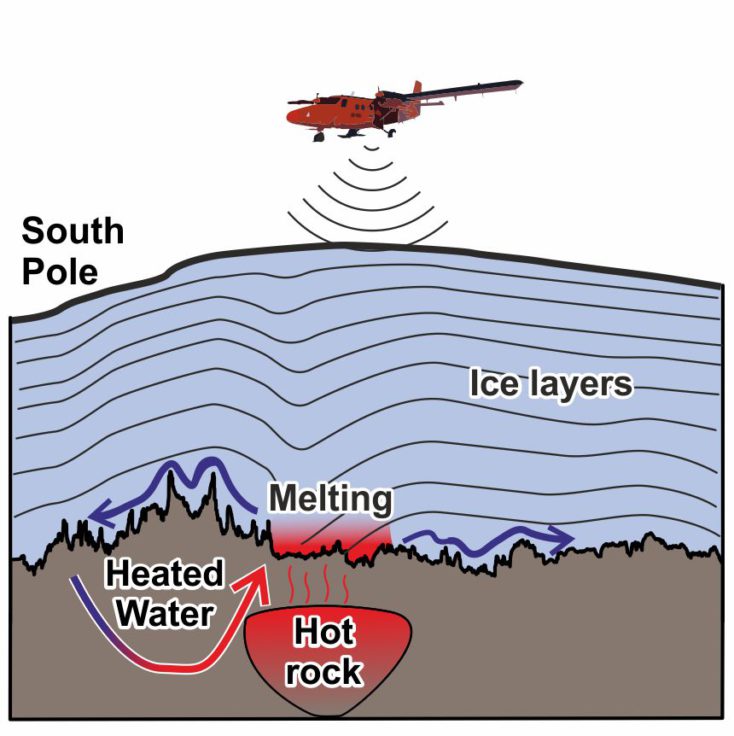Discovery of high geothermal heat at South Pole
Scientists have discovered an area near the South Pole where the base of the Antarctic Ice Sheet is melting unexpectedly quickly. Using radar to look through three km of ice, the team found that some of the ice – covering an area that’s twice the size of Greater London – appeared to be missing. The results are published this week in the journal Scientific Reports.
This new study explains how an unusual amount of geothermal heat has melted, and continues to melt, the base of the ice, resulting in the ice sheet layers above sagging downwards.
The team believes the heat source is a combination of unusually radioactive rocks, and hot water coming from deep under the ground. This heat melts the base of the ice sheet, producing melt-water which drains away beneath the ice sheet filling subglacial lakes downstream. The presence of this extra water may help lubricate the fast flowing ice in this area.

Lead author Dr Tom Jordan from British Antarctic Survey (BAS) says:
“The process of melting we observe has probably been going on for thousands or maybe even millions of years and isn’t directly contributing to ice sheet change. However, in the future the extra water at the ice sheet bed may make this region more sensitive to external factors such as climate change”.
The study collected data using a BAS aircraft as part of the PolarGAP project. This international project, funded by the European Space Agency, with researchers from Norway, Denmark and the UK, aimed to fill the gap in satellite gravity data around South Pole. Critically for this study, scientists also collected radar data revealing the thickness, structure and conditions at the base of the ice sheet.

Dr Jordan continues:
“This was a really exciting project, exploring one of the last totally un-surveyed regions on our planet. Our results were quite unexpected, as many people thought this region of Antarctica was made of ancient and cold rocks, which had little impact on the ice sheet above. We show that even in the ancient continental interior, the underlying geology can have a significant impact on the ice”.
Co-author Dr René Forsberg from the Technical University of Denmark says:
“This was a great example of how nations working together can explore the most challenging regions on our planet. In particular, we thank the US Antarctic program for their great hospitality at South Pole station, and British Antarctic Survey for their incredible logistical efficiency. It is also an example of how a project – originally designed to augment satellite data for the European Space Agency, could produce completely unexpected scientific results”.
Ends
Issued by the British Antarctic Survey Press Office:
Athena Dinar, Senior Communications Manager Tel: +44 (0)1223 221441; email: amdi@bas.ac.uk
Layla Batchellier, Press Officer Tel: +44 (0) 1223 221506; laytch@bas.ac.uk
Photos of the Twin Otter aircraft in Antarctica during the PolarGAP project are available from the BAS Press Office as above.
Lead author Dr Tom Jordan, British Antarctic Survey email: tomj@bas.ac.uk
Anomalously high geothermal heat flux near the South Pole by T.A. Jordan, C. Martin, F. Ferraccioli, K. Matsuoka, H. Corr, R. Forsberg, A. Olesen, M. Siegert is published in the journal Scientific Reports. Read it here: www.nature.com/articles/s41598-018-35182-0
PolarGAP was an ambitious international mission to capture new and critical data about the Earth’s global gravity field. Innovative radar systems and Lidar technologies were deployed from Twin Otter aircraft to fill the ‘data gap’ in measurements of surface elevation over the South Pole region south of 83.5°. Read more here: https://www.bas.ac.uk/project/polegap/